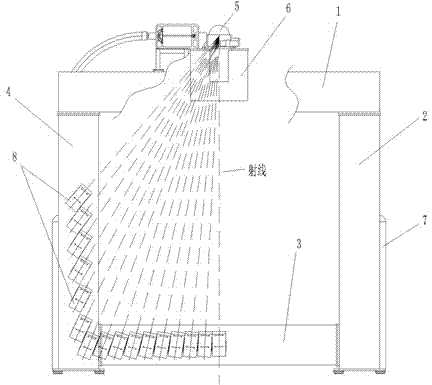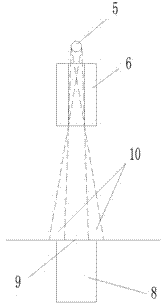Method for lowering detecting dose of radiation imaging system
A ray and ray source technology, which is applied in the field of nuclear technology applications, can solve the problems of increasing radiation safety protection structure, large detection dose, and low detection efficiency, and achieve the effect of reducing the number of rays, reducing radiation dose, and ensuring image quality
- Summary
- Abstract
- Description
- Claims
- Application Information
AI Technical Summary
Problems solved by technology
Method used
Image
Examples
Embodiment Construction
[0020] The present invention will be described below in conjunction with the accompanying drawings.
[0021] figure 1 It is a radiation imaging inspection system for inspecting vehicles. Such as figure 1 As shown, the detection system includes a frame, a radiation source, a front collimator, and an array detector. The frame is a rigid frame structure, which is formed by connecting the upper beam 1, the right column 2, the lower beam 3, and the left column 4. The radiation source 5 and the front collimator 6 are installed and fixed on the upper beam 1 and aligned with the upper beam 1 . The array detector is composed of several detectors 8, and each detector 8 may contain several detector units or only one detector unit; Arranged so that the formed array detectors are U-shaped as a whole; each detector 8 is respectively installed in the cavities in the left column 4, the lower beam 3, and the right column 2.
[0022] Of course, it is also possible to adopt a structure in w...
PUM
 Login to View More
Login to View More Abstract
Description
Claims
Application Information
 Login to View More
Login to View More - R&D
- Intellectual Property
- Life Sciences
- Materials
- Tech Scout
- Unparalleled Data Quality
- Higher Quality Content
- 60% Fewer Hallucinations
Browse by: Latest US Patents, China's latest patents, Technical Efficacy Thesaurus, Application Domain, Technology Topic, Popular Technical Reports.
© 2025 PatSnap. All rights reserved.Legal|Privacy policy|Modern Slavery Act Transparency Statement|Sitemap|About US| Contact US: help@patsnap.com


